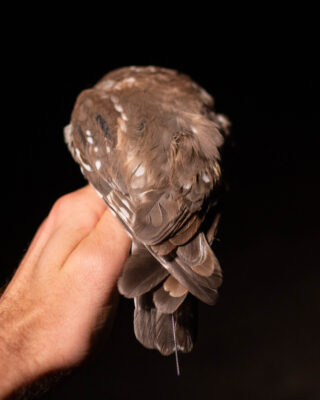Northern Saw-whet Owl Migration Monitoring
Objectives
This project addresses knowledge gaps in the ecology of Northern Saw-whet Owl (NSWO; Aegolius acadicus), a small yet fearsome predator that was not known to occur regularly in the Interior Highlands prior to the 2010s.
To accomplish our goals, we will continue to conduct fall migration monitoring of NSWO at our 10-year banding site. This will also include deploying Motus nanotags as part of a larger effort to gain insight into NSWO migration in eastern North America.
The NSWO is one of the smallest and most abundant owls in North America. Their range encompasses much of the continent’s forested regions.
During the breeding season (spring and summer), they can be found in the northern half of the continent, and in the Rocky and Appalachian Mountains.
During the nonbreeding season (fall and winter), NSWO migrate long distances. For decades, scientists have captured and banded NSWO during fall migration to gather important information about their movements and demographics.
Nevertheless, their silent nature in fall and winter means these tiny owls are quite difficult to detect outside banding operations.
Many questions remain about how widespread NSWO are during fall and winter, including how far south the species ranges. Because banding efforts have historically been centered on Canada and the northern U.S., data in the southern U.S. is limited. However, limited data and historic records show NSWO likely spend winter further south than they were historically believed to, including in Arkansas!
Our NSWO project is entering its 10th year in 2024, with more than 150 owls captured. Just a decade ago, the species was not known to occur regularly in Arkansas! Through diligent research, we now know they inhabit the region’s pine forest during fall and winter and are likely common, though quiet and difficult to find.
This work will allow us to better understand migration patterns in NSWO, in an effort to uncover regional trends and recommend conservation status. We are a proud collaborator of Project Owlnet, a network of scientists studying owls across the continent. Through this network, our data will go to direct use in planned studies to assess migration patterns and long-term trends at a continental scale.
Beginning in fall 2024, we will deploy Motus nanotags on some NSWO! With these incredibly lightweight transmitters, we hope to gain insight into how NSWO are migrating between breeding and wintering areas for up to 2 years.
The Motus Wildlife Tracking System is an open source project that uses transmitters set to a certain frequency that are read by a network of Motus-specific towers.
The Motus Wildlife Tracking System has already proven invaluable in better understanding the movements of migratory species like NSWO, and we are excited to be playing a part!
Stay up to date on the movements of our owls and others in North America!
This exciting new facet to our NSWO research is thanks to collaborators in Oklahoma, as well as the Arkansas Audubon Society Trust, and the Northwest Arkansas Audubon Society.

